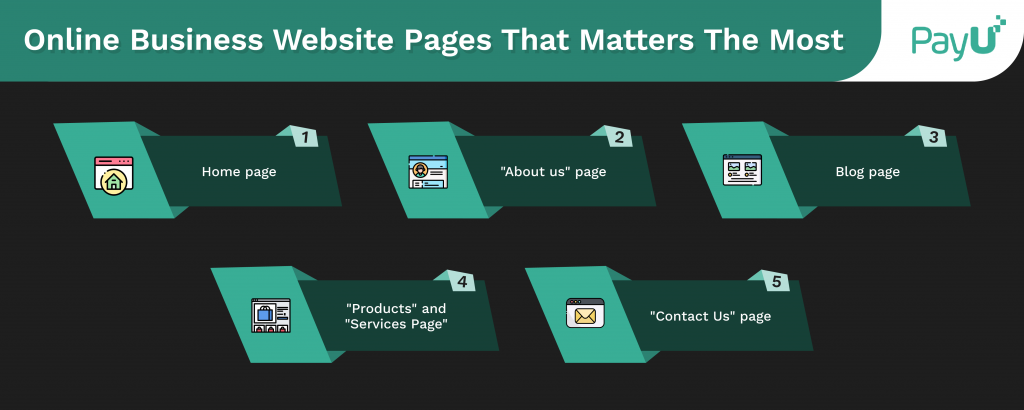With a consumer’s attention span less than that of a goldfish, it can be challenging to keep them put and check out with a purchase. These website pages are basic and unputdownable for online businesses.
Your business website is the face of your brand and a digital placard to the outside world. While it takes 50 milliseconds for a user to judge your website—whether they’ll stay or not—it is essential to appeal to them, if not win them over all the time. It goes without saying that your website should be designed to appeal to prospective customers, inform them about your products or services, and prompt action, all designed to work together in a very short time. Is it challenging? Not really, without some expert guidance and proper planning. So, if you’re designing a new website or revamping the old one, you have reached the right place. This article talks about the online business website pages that matter the most. Here is a list of the most important web pages that your business website must have.
Your website is not just about its looks and colours. It should be carefully designed with relevant content in the right places to meet the visitors’ expectations. Here’re the pages you must have:

Home page
Your website homepage is your most-visited page. Thus, it should be able to grab the visitor’s attention instantly. This can be achieved with a well-designed and professional-looking website using excellent graphics and a clean and uncluttered UI. In addition, it needs to have faster loading times (both on desktop and mobile) since the longer it takes to load, the more likely visitors will abandon the webpage. Google reports that 61% of visitors are reluctant to revisit a mobile website if they encounter access issues, and 40% will go to a competitor’s website. The stakes are high here! That is why the homepage must briefly describe who you are, what you do, and a glimpse of the products and services you provide along with a strong CTA.
However, resist the urge to put every fact about your business on the homepage simply because it will make it unnecessarily crowded. The homepage of a website is where the first impression is made, and it should guide and convince the visitors to take the next step and complete their buying journey with you.
“About us” page
The About Us website page tells visitors about the company, its history, values, and vision, and most importantly, about the people behind it. In today’s day and age, buyers are conscious; it means they’ll first align their values with that of the brand to make a purchase. That is why ensuring your brand’s vision, mission and values are eloquently uploaded on the “about us” page.
Make it exciting and relatable to the people. Present your brand story to the audience in a fun and engaging manner. Let them know how the founders or owners came up with the business idea and what makes them different from the competition. This important website page allows you to form a connection with the target audience.
Blog page
A blog website page contains topical posts in reverse chronological order, with the most recent blog appearing first. Blogs are the most affordable and effective digital marketing tool. They drive the right audience to your website and increase sales. A HubSpot survey revealed that 57% of businesses with a blog had generated at least one lead from it.
You need to have a strategy for your blog. Consider who you’re blogging for and the topics that would be covered. Relevant, in-depth, SEO-optimised blog posts are highly effective as they rank higher in search results and are shared more often on social media. Thus, your blog page is your voice.
Read more – How To Write A Blog: 7 Steps To Get Started!
“Products” and “Services Page”
Most consumers visit your website to learn about your products and services. This page can be as brief or extensive as you want. For instance, you can divide the products and services into categories and discuss them. Provide detailed information about each product and add links to product pages. The goal is to answer customer queries without them having to look for explanations. Be sure to give users the greatest experience possible while designing your service pages. Make it simple for them to discover the details of your offerings. In addition to emphasising the user in your copy, you should also include components that will increase the page’s interactivity—graphics, bars, pie charts or whatever is applicable. Leads will stay on your website longer to discover more about your offerings and get in touch with your company in these ways.
“Contact Us” page
This website page is essential for small businesses, startups, and freelancers. It provides potential customers or clients with the means to get in touch with you and is critical to credibility. Your contact us page can include phone numbers, email addresses, physical mailing addresses, and links to your social media pages. The contact webpage page can also have a contact number to reach a customer care representative. If you’re an eCommerce business needing an online payment gateway on your website, the payment gateway service provided will demand a clear “contact us” page before offering the service. So, you can judge the importance of this page.
Checkout page
The checkout page is the final destination for a consumer who decides to buy your product. The webpage is where payment is made, and the online transaction is completed. It may consist of two or more processes. Typically, a checkout page has the steps to include the delivery address and mode of payment but some have more. A choppy and slow checkout page can add to your business’s cart abandonment rate, which is bad. So, ensure that your checkout page is as smooth and optimised as your homepage or other website pages.
eCommerce stores can use the payment gateway provided by PayU on their checkout page to ease the payment process for customers.
Final Thoughts
Each business is unique in itself, and its website is a way to reflect that uniqueness. Thus, every business should design a website depending on its brand identity and image and how it wants to connect with its target audience. Please remember that the website design must be customer-forward, not what your company wishes or likes.
If you’re in the process of building your website, PayU can help you with one page, which is the checkout page of your website. PayU offers a seamless and simplified checkout experience and optimises payments on your website and app, killing the chances of cart abandonment for poor UI experience. So, for any help regarding your checkout page, contact us today!
FAQs
The necessary pages required by most websites are the homepage, about us, contact us, products, checkout, and blog pages.
The homepage is like an introduction to your business. There should not be a lot of information stuffed on the homepage. It should give a clear idea of who you are and what you do briefly. It can also tell how the company’s products or services can help potential customers. Most importantly, it must have a CTA.
A checkout page is an essential webpage for any eCommerce business. Consumers reach this page when they are about to make payment for the products they purchased. You can get in touch with PayU to build a checkout page that gives a smooth payment experience to your customers.



